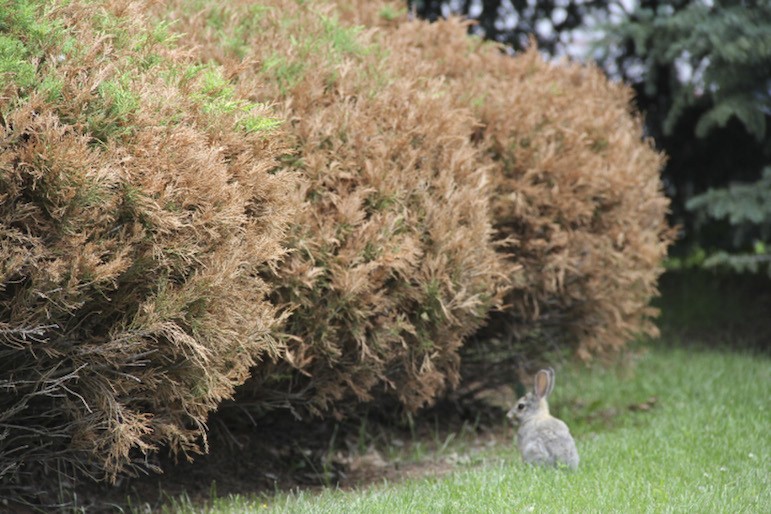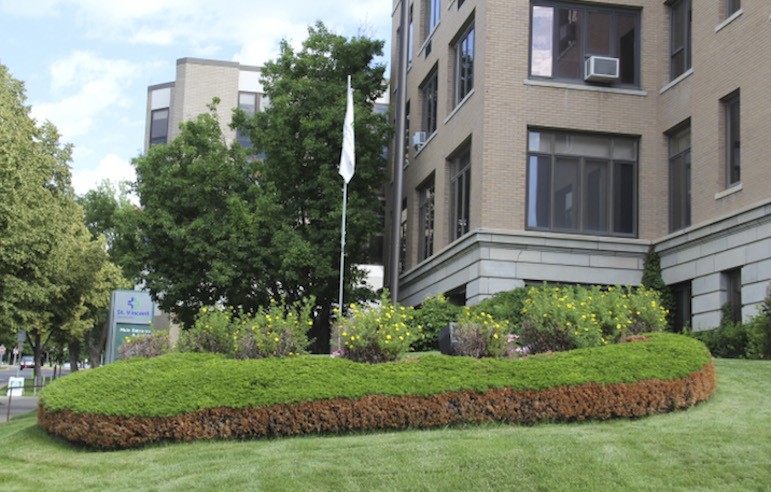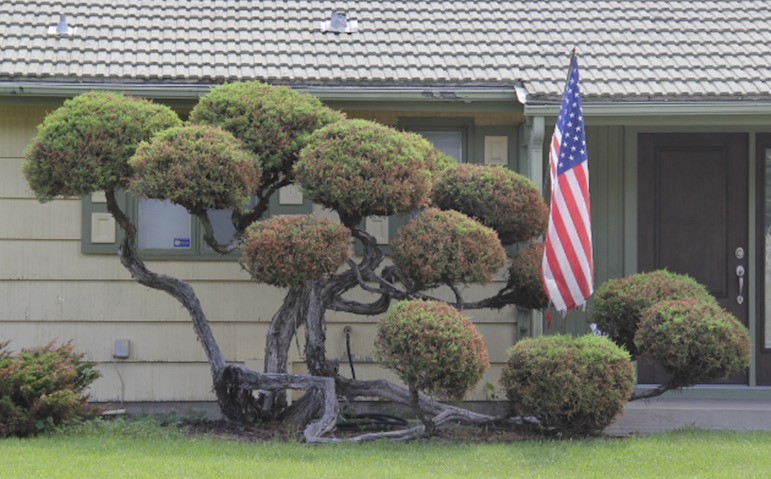Winter burn on trees, shrubs is the worst in decades

Ed Kemmick/Last Best News permalink
Still life with winter-burned juniper bushes and rabbit, near Division Street and Burlington Avenue. Click on the arrows for more photos.

Ed Kemmick/Last Best News permalink
In some cases the winter burn is so attractive it almost looks intentional, as here on the St. Vincent Healthcare campus.
Ed Kemmick/Last Best News permalink
A row of winter-burned arborvitae on 1100 block of Eighth Street West.

Ed Kemmick/Last Best News permalink
Sculpted juniper bushes, partly damaged by winter burn, on the 2400 block of 11th Street West.
Everywhere you go in Billings, the effects of last November’s harsh temperatures are starkly apparent.
Two of the most common trees and shrubs—junipers and arborvitae—were hit hard by the early freeze, leaving thousands of the plants with brown, dead-looking foliage.
But it turns out the damage is much worse than you might think. Amy Grandpre, the horticulture assistant with the Yellowstone County Extension Service, said numerous other species of trees and shrubs were hammered as well, including fruit trees, elm trees and burning bushes, the ones that display bright crimson leaves.
“It’s kind of escalating,” she said. “First it was evergreens and now it’s all kinds of things.” Grandpre said the damage inflicted this winter was the worst she’d seen in her 35 years with the extension service.
Richard Marble, the owner of Billings Nursery and Landscaping, said he’s witnessed nothing like it in his nearly 45 years in the business.
“This is by far the worst I’ve seen it,” he said. “This is across the board. It hit everything.”
Steve Riley, the acting forester for the city’s Parks and Recreation Department, said five or six dead crab apple trees had to be removed from city parks, and there are some Siberian elm trees that are “just kind of hanging on” and will have to be monitored.
He said he has also been getting a lot of calls from people worried about their trees. Most of the calls are about elms, he said, because many of them have no leaves yet, or just scattered tufts of leaves, and people think they’re diseased.
Marble said he has customers with 50-plus fruit trees who lost 40 of them. Siberian elms, ash and evergreens were also hard hit, he said, and spruce and pine trees, too, though to a lesser extent.

Ed Kemmick/Last Best News
Many shrubs and trees, like these arborvitae on 3400 block of St. Johns Avenue, suffered winter burn only on one side.
Many of the evergreens suffered only winter burn, not winter kill, Marble and Grandpre said, and they will come back in time. But as Marble said, “they’re just going to look really rough for a long time.”
The damage occurred last November, which started out unseasonably warm and then grew bitterly cold in a big hurry. According to the National Weather Service, the high in Billings on Nov. 8 was 69. By Nov. 11 it had plunged to 1 below zero, then 4 below on Nov. 12 and 8 below on Nov. 13.
Compounding the damage, it warmed up again, hitting 61 degrees by Nov. 28 before dropping to 4 below on Nov. 29 and 8 below on Nov. 30. Elsewhere in Montana, temperatures of 20 below were not uncommon in November.
Because the trees were still actively growing and were not yet dormant when the temperatures plunged, the cold, snow and wind all conspired to burn the foliage.
Grandpre said people can determine whether their trees and shrubs are dead or merely damaged by checking for new growth or testing limbs for flexibility. If new growth is visible or there is still spring in the limbs, the plants will eventually come back, though they might remain brown for several years.
To help them recover, she said, don’t fertilize them. Just make sure they get enough, but not too much, water. An extension service guide to watering will help you figure out how much is enough. Grandpre also recommended putting on gardening gloves and gently rubbing shrubs with burned leaves, to remove the dead ones.
Marble said another consequence of the winter burn is that many trees and shrubs will now be more susceptible to hail damage and to incursions by boring insects.
And then there’s the possibility of a repeat of last year’s damage.
“If we get that again this fall,” Riley said, “it could be devastating.”
Comments
comments








